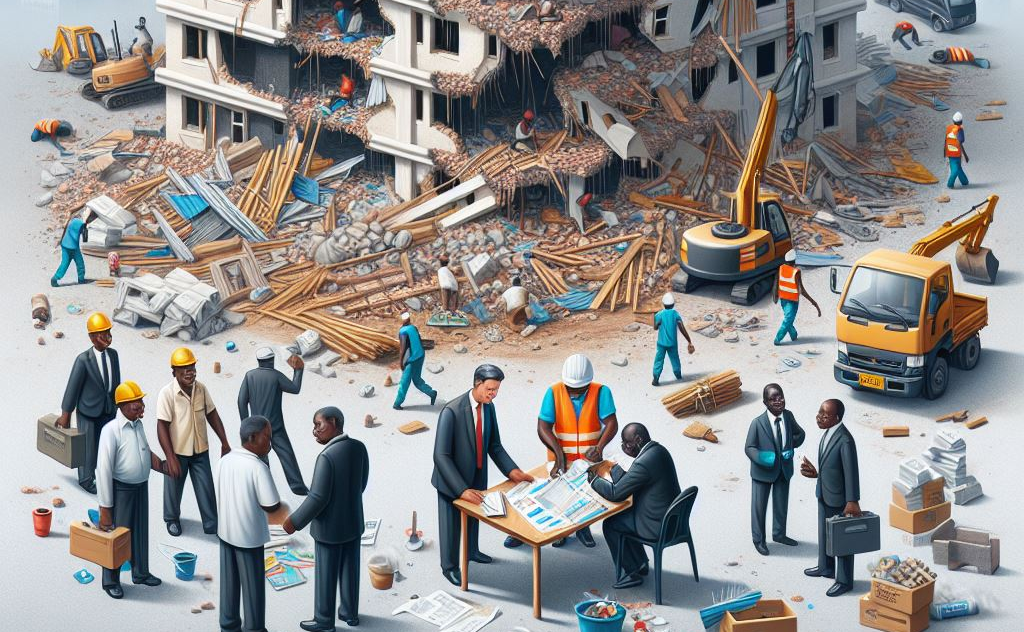The crisis of building collapses in Africa
Building collapses are a recurring tragedy across Africa, claiming lives and eroding trust in urban development. These incidents, which often make headlines, are the result of deeper systemic issues, including weak regulatory frameworks, corruption, substandard materials and unqualified labour, writes John Ridgeway.
In Nigeria, building collapses are alarmingly common. As of 2024, 43 building collapses were recorded, with major incidents in urban hubs like Lagos and Abuja. These disasters highlight the pressing need for reform in construction practices. Despite Nigeria’s urbanisation boom, safety has lagged behind as cost-cutting measures undermine building integrity. (Please note: we have used AI generated images to illustrate this blog)
The issue extends beyond Nigeria. Countries like Kenya, Ghana, and Uganda also face similar challenges. Rapid urbanisation has placed immense pressure on construction industries, often prioritising speed and profit over safety. Conversely, countries such as South Africa and Rwanda have introduced stricter regulations, resulting in fewer incidents, but these are exceptions rather than the rule.
To get a better understanding of the problem, we need to look at the root causes of building collapses. Many African countries have building codes, but enforcement remains inconsistent or non-existent. Inspections are often skipped and projects proceed without proper oversight.
In some cases, building codes are outdated, failing to account for modern engineering practices and materials. The use of inferior cement, steel and other materials is also widespread, with many contractors opting for cheap, substandard imports to reduce costs.
Fake building materials, including subpar cement and defective reinforcement bars, flood African markets, further compromising structural integrity. This is compounded by the construction workforce, which often lacks formal training, relying instead on unskilled or minimally trained labourers.
To make matters worse, licensed engineers and architects are sometimes bypassed in favour of cheaper, less qualified individuals. Corruption also undermines regulatory enforcement, with inspectors accepting bribes to overlook non-compliance. It is also not unknown for politicians and influential figures to sometimes shield errant contractors from accountability.
Like most of the developing world, cities are expanding in Africa at unprecedented rates, straining infrastructure and creating a rush to build quickly. This is turn has led to the proliferation of informal settlements with poorly constructed homes and structures. Put all these issues together and it adds up to the perfect storm.
Human and economic consequences
Building collapses result in tragic loss of life, often affecting the most vulnerable, such as construction workers and residents. For example, a high-profile collapse in Nairobi in 2023 killed over 20 people and left many injured. The psychological impact on survivors and communities is profound. At the time of writing another 42 people have reportedly died in another collapse in Dar a salam.
The economic toll of collapses is also immense. Governments and developers bear the costs of reconstruction, while affected families face medical expenses and loss of income. The broader economy suffers as public trust in development and construction diminishes.
Frequent collapses deter investment in urban development projects. When safety is compromised, international investors and donors are understandably reluctant to fund construction initiatives, stalling progress in key sectors like housing and infrastructure.

However, it is not all bad news. Countries like South Africa and Rwanda have set examples by enforcing stringent building codes and conducting regular inspections. Adopting similar practices across the continent is critical and shows that it can be done with strong Government in place. They must empower regulatory bodies to operate independently and transparently. Regular audits and site inspections should become standard practice.
Investing in vocational training for construction workers would be another positive step forward to improve workmanship and adherence to safety protocols. Educating developers, contractors and the public about the importance of compliance with safety standards is also vital.
There must be more anti-corruption measures, including harsher penalties for bribery and mismanagement, to deter malpractice. Digital tools for tracking permits and inspections can also enhance accountability. This could include technologies like drones and AI, which could be used to monitor construction projects and detect potential safety violations. Advanced testing methods are also needed to verify the quality of materials before they are used in construction.
South Africa’s strict standards
As already mentioned, South Africa’s construction industry adheres to one of the most comprehensive building codes on the continent. Regular inspections and legal penalties for violations have significantly reduced collapses – and this could act as a template for the rest of the continent.
Similarly, Rwanda’s government has made strides in urban planning and construction oversight. By adopting a centralised system for permit approvals and inspections, the country has improved safety outcomes.
While Kenya has introduced reforms, challenges persist. In response to recent collapses, the government has increased penalties for non-compliance and mandated more frequent inspections.
There are further reasons for optimism. Trade groups are playing a more crucial role in highlighting the dangers of poor construction practices. In Nigeria, Kenya and Ghana they have been instrumental in raising awareness and pushing for stricter enforcement of regulations.
So, where does Africa go from here. Establishing centralised databases to track construction projects, permits, and inspections can enhance transparency and accountability and would be a good start. Empowering communities to participate in monitoring construction projects would also serve as an additional layer of oversight. Furthermore, governments should impose strict penalties, including imprisonment, for contractors and developers found guilty of gross negligence.
Building collapses in Africa represent a multifaceted crisis rooted in systemic failures. However, with concerted efforts to reform regulations, combat corruption and educate stakeholders, significant progress is possible. Governments, developers, and communities must work together to ensure that construction practices prioritise safety and sustainability, safeguarding lives and fostering trust in urban development. The road ahead requires resilience and innovation, but the cost of inaction is far too high to ignore.
Additional Blogs

How construction can cut Its carbon footprint by caring for soil
Soil is often dismissed as mere dirt, but it is one of the planet’s most powerful carbon stores, holding more than all of the world’s forests combined. Yet in our rush to build, pave and develop, we...
Read moreWhat is bridging damp? How it happens and how to fix it
Bridging damp happens when moisture finds a path around the building’s damp-proof course (DPC) so it reaches your internal walls and skirting. If you see damp patches rising above the skirting or...
Read more

The silent death of the fixed-price contract
For decades, the fixed-price contract has been the backbone of construction procurement. It promised certainty with a defined scope, an agreed sum and a clear transfer of risk from client to...
Read more